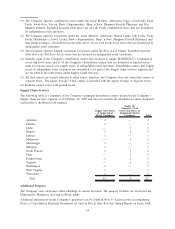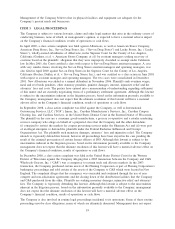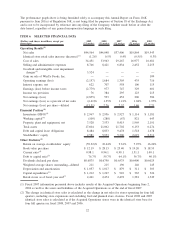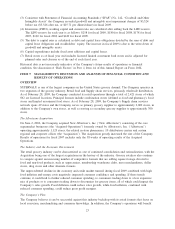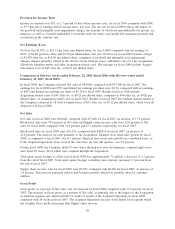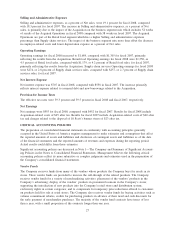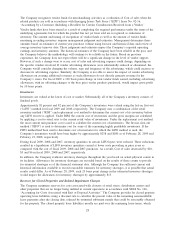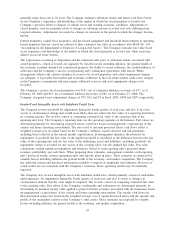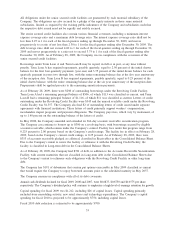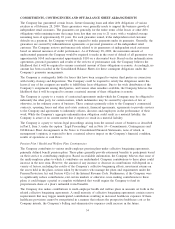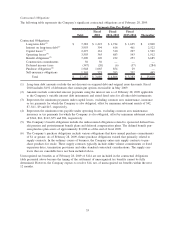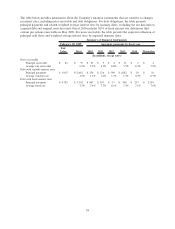Albertsons 2009 Annual Report Download - page 32
Download and view the complete annual report
Please find page 32 of the 2009 Albertsons annual report below. You can navigate through the pages in the report by either clicking on the pages listed below, or by using the keyword search tool below to find specific information within the annual report.The Company recognizes vendor funds for merchandising activities as a reduction of Cost of sales when the
related products are sold in accordance with Emerging Issues Task Force (“EITF”) Issue No. 02-16,
“Accounting by a Customer (Including a Reseller) for Certain Consideration Received from a Vendor.”
Vendor funds that have been earned as a result of completing the required performance under the terms of the
underlying agreements but for which the product has not yet been sold are recognized as reductions of
inventory. The amount and timing of recognition of vendor funds as well as the amount of vendor funds
remaining in ending inventory requires management judgment and estimates. Management determines these
amounts based on estimates of current year purchase volume using forecast and historical data and review of
average inventory turnover data. These judgments and estimates impact the Company’s reported operating
earnings and inventory amounts. The historical estimates of the Company have been reliable in the past, and
the Company believes the methodology will continue to be reliable in the future. Based on previous
experience, the Company does not expect there will be a significant change in the level of vendor support.
However, if such a change were to occur, cost of sales and advertising expense could change, depending on
the specific vendors involved. If vendor advertising allowances were substantially reduced or eliminated, the
Company would consider changing the volume, type and frequency of the advertising, which could increase or
decrease its advertising expense. Similarly, the Company is not able to assess the impact of vendor advertising
allowances on creating additional revenues as such allowances do not directly generate revenue for the
Company’s stores. For fiscal 2009, a 100 basis point change in total vendor funds earned, including advertising
allowances, with no offsetting changes to the base price on the products purchased, would impact gross profit
by 10 basis points.
Inventories
Inventories are valued at the lower of cost or market. Substantially all of the Company’s inventory consists of
finished goods.
Approximately 81 percent and 82 percent of the Company’s inventories were valued using the last-in, first-out
(“LIFO”) method for fiscal 2009 and 2008, respectively. The Company uses a combination of the retail
inventory method (“RIM”) and replacement cost method to determine the current cost of its inventory before
any LIFO reserve is applied. Under RIM, the current cost of inventories and the gross margins are calculated
by applying a cost-to-retail ratio to the current retail value of inventories. Under the replacement cost method,
the most current unit purchase cost is used to calculate the current cost of inventories. The first-in, first-out
method (“FIFO”) is used to determine cost for some of the remaining highly perishable inventories. If the
FIFO method had been used to determine cost of inventories for which the LIFO method is used, the
Company’s inventories would have been higher by approximately $258 and $180 as of February 28, 2009 and
February 23, 2008, respectively.
During fiscal 2009, 2008 and 2007, inventory quantities in certain LIFO layers were reduced. These reductions
resulted in a liquidation of LIFO inventory quantities carried at lower costs prevailing in prior years as
compared with the cost of fiscal 2009, 2008 and 2007 purchases. As a result, Cost of sales decreased by $10,
$5 and $6 in fiscal 2009, 2008 and 2007, respectively.
In addition, the Company evaluates inventory shortages throughout the year based on actual physical counts in
its facilities. Allowances for inventory shortages are recorded based on the results of these counts to provide
for estimated shortages as of the financial statement date. Although the Company has sufficient current and
historical information available to record reasonable estimates for inventory shortages, it is possible that actual
results could differ. As of February 28, 2009, each 25 basis point change in the estimated inventory shortages
would impact the allowances for inventory shortages by approximately $13.
Reserves for Closed Properties and Related Impairment Charges
The Company maintains reserves for costs associated with closures of retail stores, distribution centers and
other properties that are no longer being utilized in current operations in accordance with SFAS No. 146,
“Accounting for Costs Associated with Exit or Disposal Activities.” The Company provides for closed property
operating lease liabilities using a discount rate to calculate the present value of the remaining noncancellable
lease payments after the closing date, reduced by estimated subtenant rentals that could be reasonably obtained
for the property. The closed property lease liabilities usually are paid over the remaining lease terms, which
28


